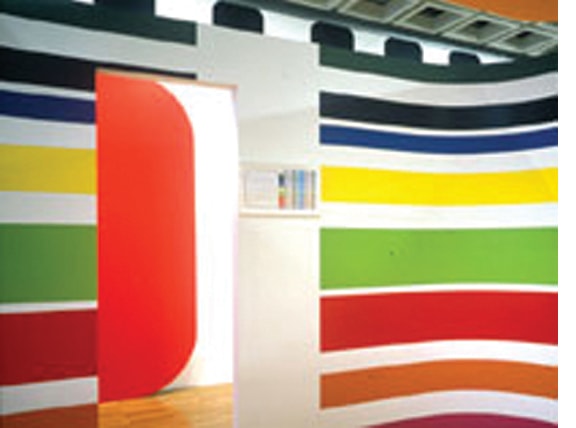studios

GAIL HASTINGS
–
sculpture: a conversation (between three) is a super 8 film made in 1988 submitted as my third year art history thesis at the Victorian College of the Arts, Melbourne. It was screened as part of the graduation-thesis exhibition at the Victorian College of the Arts Gallery, 1988, and was accompanied by a display of the conversation/text/image photographs seen in the film. The conversation snippets were derived from those I overheard and took note of. The photographed text is taken from D. H. Lawrence’s novel, ‘Women in Love’ (completed in 1916). The extracts are of a conversation about sculpture. It is where Loerke, the artist who Gudrun has taken an interest in, shows the two sisters a photo gravure of a statuette he has made, a naked girl on a horse. Ursula is disturbed by the image. A conversation ensues where Ursula trades observations of the work with Loerke who counters them along with Gudrun who angrily rejects them, embarrassed by her sister. Ursula asks why Loerke made a sculpture of a horse that ‘is a picture of himself, really’. Loerke answered with derision that this ‘is a Kustwerk, a work of art. It is a work of art, it is a picture of nothing, of absolutely nothing. It has nothing to do with anything but itself, it has no relation with the everyday world of this and the other, there is no connection between them, absolutely none, they are two different and distinct planes of existence, and to translate one into the other is worse that foolish, it is a darkening of all counsel, a making confusion everywhere. Do you see, you must not confuse the relative world of action, with the absolute world of art. That you must not do.’ Furious, Ursula ‘wanted to poke a hole into them both. “It isn’t a word of it true, of all this harangue you have made me”’, she said. ‘The horse is a picture of your own stock stupid brutality, and the girl was a girl you loved and tortured and then ignored.‘
While a differentiating line between non-representational art (self-referential) and representational art (external referent, such as a horse) is awkward here, what was thrilling when I read this as a sculpture student was that a conversation about a traditional sculpture took the place of that sculpture. In fact—contrary to the condemnation of non- or self-representational works of art that the passage perhaps sets out to do—what is most important in life or ‘the relative world of action’ can actually take place through the ‘nothing’ or ‘empty’ centre of a non-representational work of art: the aesthetic struggle where prejudices are faced through an intersubjective engagement—a conversation.
Situation no. 41: happy new year, 2000, is seen here in a group exhibition at the Art Gallery of New South Wales in 2000. A sculptural situation is for me an answer to the spatial conundrums left by Minimalism where a work of art, previously autonomous, now includes a viewer’s intersubjective relation to it. A sculptural situation, therefore—unlike installation or site specific work—becomes its own site: an autonomous space that one is both outside of (as with a sculpture) and inside of (as with a situation) at one and the same time. It is, literally, a double space occurring concurrently through its ‘empty’ centre. Orientation within it works through a relation of real objects and actual space to a fictional floorplan and conversation. In situation no. 41 the floorplan is a duplication of the pattern motif seen in the ‘famous fabric pattern’ fragment (and which you can see repeated as the overall sculptural situation). Its fictional watercolour conversation (hanging on the outside of the painting/room) continues this pattern of repeats. In this instance the curator thankfully agreed to participate in the work’s fiction by filling in a form, seen inside the door of the painting/room, that tracked the time taken for a greeting card the same colour as each stripe to be received by the curator through the post. The time taken was then converted into a measurement for the width of each colour stripe and space in between. A sculptural situation’s fiction then, its mythical floorplans, instructions and conversations, are always a pretense by being preformed rather than performed by the viewer. In detective/noir terms it is a ‘set-up’; not unlike a vacated scene from a movie, replete with detail, where the plot is yet to occur. For a sculptural situation is an invisible architecture around an empty centre where a viewer’s engagement takes central place—their conversation—no matter whether their conversation is in the form of feelings, thoughts, words or movement through the work’s autonomous space.
Gail Hastings
Sydney
September 2005